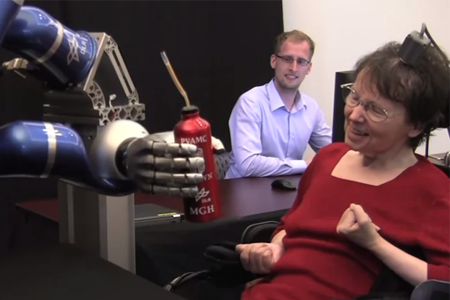WATCH: Paralyzed Woman controls Robot Arm With Her Mind. Yeah, Science!
This right here is the berries. Harnessing powerful brain heft and science wizardy, the thinking minds of Brown University have created BrainGate. This batch of science magical (cause c’mon it’s pretty surreal) has allowed a woman named Cathy to control a robot arm. With her fucking mind.
Boing Boing:
In this video, a woman known as Cathy, who is unable to speak or move any of her limbs or torso, controls a robot arm with her mind to take a sip of coffee. This fantastic breakthrough is reported in the current issue of the science journal Nature. Cathy has been implanted with a BrainGate neural interface (below left), the same technology that previously enabled two individuals to control computer cursors with thought alone. One of the lead researchers is Brown University neuroengineer Leigh Hochberg. I visited Leigh more than 13 years ago when he was a grad student at Emory University. He introduced me to monkeys who had received neuroimplants in his lab. At the time, Leigh was just trying to record the signals from the monkeys’ brains while also dealing with the implants’ proclivity to move around, reducing the quality of the signal over time. Leigh was humble, cautiously optimistic, and deeply dedicated. Amazing how far this research has come. From Nature:
The (latest) study participants – known as Cathy and Bob – had had strokes that damaged their brain stems and left them with tetraplegia and unable to speak. Neurosurgeons implanted tiny recording devices containing almost 100 hair-thin electrodes in the motor cortex of their brains, to record the neuronal signals associated with intention to move.
In a trial filmed in April last year and presented with the paper, Cathy, who had her stroke 15 years ago and received the implants in 2005, used her thoughts to steer a robot arm to grasp a bottle of coffee and lift it to her lips. She drank and smiled.
‘We’ll never forget that smile,” says Hochberg…
In the longer term, the scientists want to dispense with the wires that must be attached to a patient’s skull; wireless systems are in development… Even further in the future, researchers hope to dispense with the robot arms and direct




